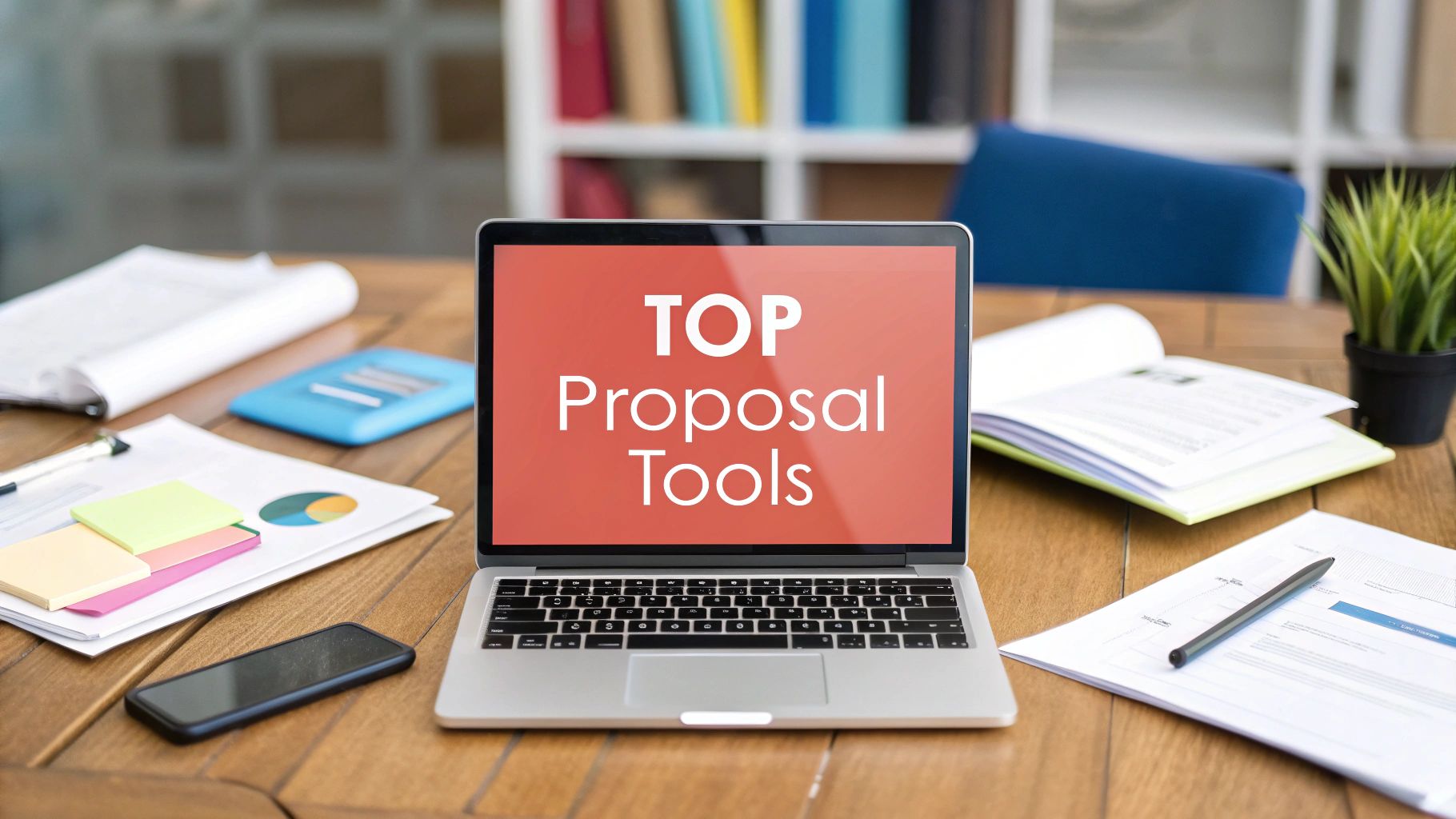For any agency, the proposal is the most critical stage of the sales cycle. It's where potential turns into profit. Yet, many agencies still struggle with clunky, time-consuming proposal processes that rely on outdated templates and manual data entry. This not only drains valuable resources but also increases the risk of errors and missed opportunities, ultimately hurting your close rate.
The solution lies in leveraging dedicated proposal software designed to streamline workflows, enhance professionalism, and provide critical insights into client engagement. A robust platform can transform your proposal from a static document into an interactive, trackable sales asset. This guide eliminates the guesswork by diving deep into the top 12 proposal software solutions specifically curated for agencies.
We'll move beyond generic feature lists to provide you with:
- Agency-Specific Use Cases: See how each tool fits into a creative, digital, or development agency's workflow.
- Honest Limitations: Understand the real-world drawbacks of each platform before you commit.
- Direct Comparisons: Get screenshots, pricing details, and direct links to help you make a faster, more informed decision.
This resource is built to help you find the platform that will not just create documents, but consistently close more deals for your agency. Let's find the right fit for your team.
1. Scribbl For Sales: Best for Nailing Agency Discovery Calls & Automating Proposal Drafts
Scribbl For Sales carves out a unique and powerful niche in the proposal software landscape by focusing on the most critical phase for any agency: the pre-proposal discovery call. Instead of just helping you format the final document, Scribbl’s AI meeting assistant ensures the information going into your proposal is flawless from the start. It automatically records, transcribes, and summarizes client conversations from Google Meet, Zoom, and Teams, eliminating the risk of misinterpreting agency scope from scattered notes. For agencies, this tool is a strategic asset for creating highly accurate, client-centric proposals that win deals.
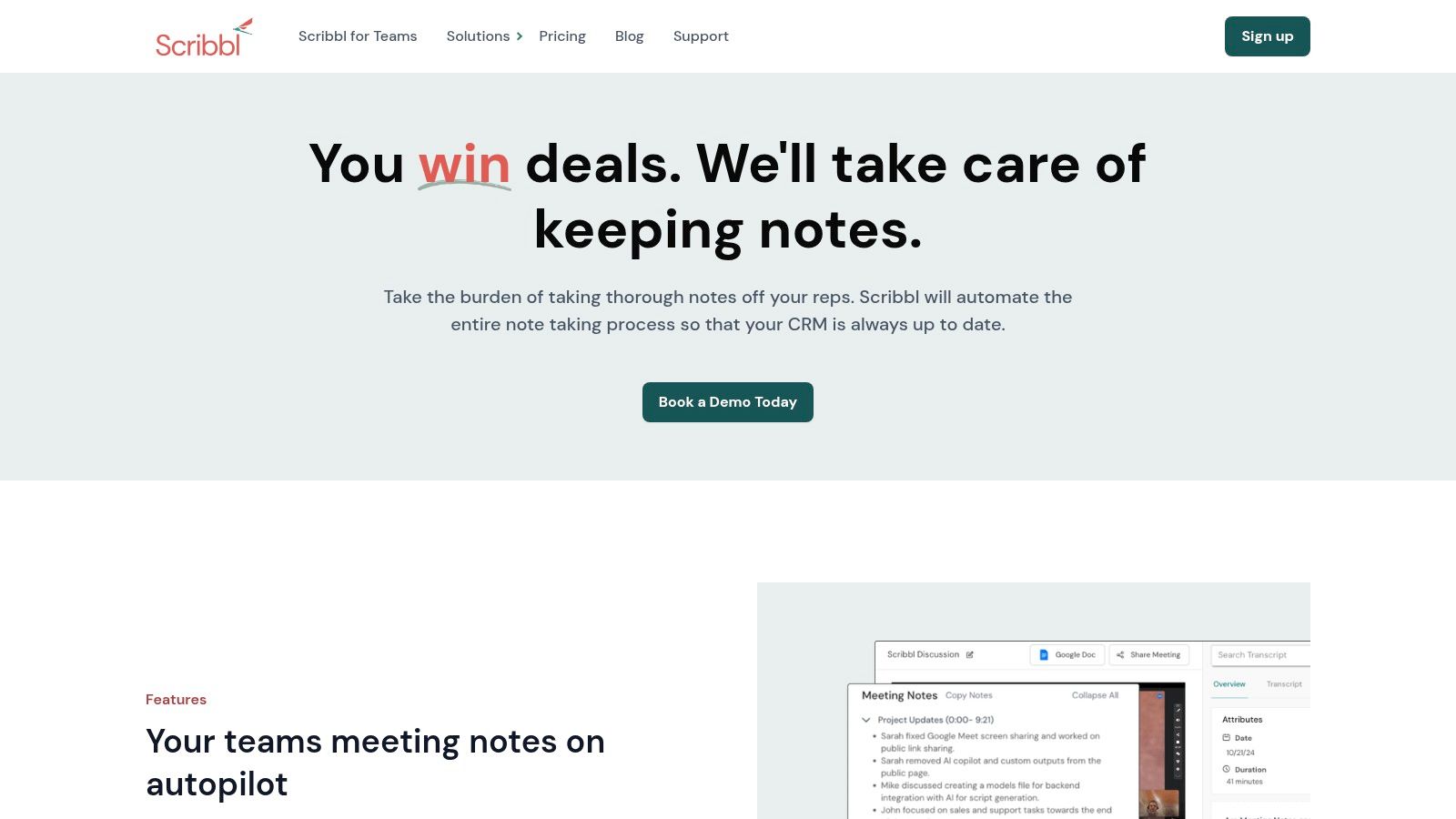
The platform’s real power for agencies lies in its ability to transform raw conversation data into actionable intelligence. The AI-generated summaries pinpoint key client requirements, budget discussions, and decision-maker priorities. It even identifies potential scope creep warnings and upsell opportunities that a busy account manager might miss. This intelligence becomes the foundation for an automatically drafted proposal, ensuring every detail from the call is accurately reflected. This process significantly accelerates the agency sales cycle and strengthens client trust from the very first interaction.
Key Strengths for Agencies
- Automated Discovery Capture: Agencies can automatically capture every detail from sales calls without intrusive bots. This ensures the entire team, from sales to project management, has a single source of truth for client needs.
- AI-Powered Insights: Scribbl analyzes transcripts to highlight risks, opportunities, and action items. This helps agency account teams proactively address concerns and identify areas to add more value.
- CRM & Workflow Integration: With native integrations for HubSpot, Salesforce, and other tools, Scribbl automates post-meeting tasks like updating CRM records and creating project tickets, streamlining the entire agency sales-to-delivery pipeline.
- Time Savings: By automating note-taking, summaries, and initial proposal drafting, Scribbl saves agency sales and account teams up to five hours per week, allowing them to focus on building client relationships rather than administrative work. The platform's approach is a masterclass in effective client communication. To refine your team's approach, you can learn more about client communication best practices here.
Pricing & Implementation for Agency Teams
Implementation Tip: While Scribbl relies on a Chrome extension, onboarding is straightforward. The key is to train your agency team to trust the AI summaries and integrate them into their daily workflow, especially for handoffs between sales and project management teams.
Pros & Cons for Agencies
- Pro: Automatically transcribes and records meetings without intrusive bots.
- Pro: Generates actionable AI summaries that flag upsells and project risks.
- Pro: Integrates with major CRMs to streamline post-meeting workflows.
- Con: Primary reliance on a Chrome extension limits use to supported browsers.
- Con: Maximizing the value of advanced AI features requires some initial team training.
Visit the Scribbl For Sales website to learn more.
2. PandaDoc: Best All-in-One Tool for Agency Proposal & Closing Workflows
PandaDoc excels as an all-in-one proposal, quote, and e-signature platform, making it a powerful choice for agencies seeking to streamline their entire document workflow from creation to close. It strikes a strong balance between a user-friendly proposal editor and robust sales enablement features. This makes it ideal for US-based SMB and mid-market agencies that need to produce professional, branded documents quickly without a steep learning curve.
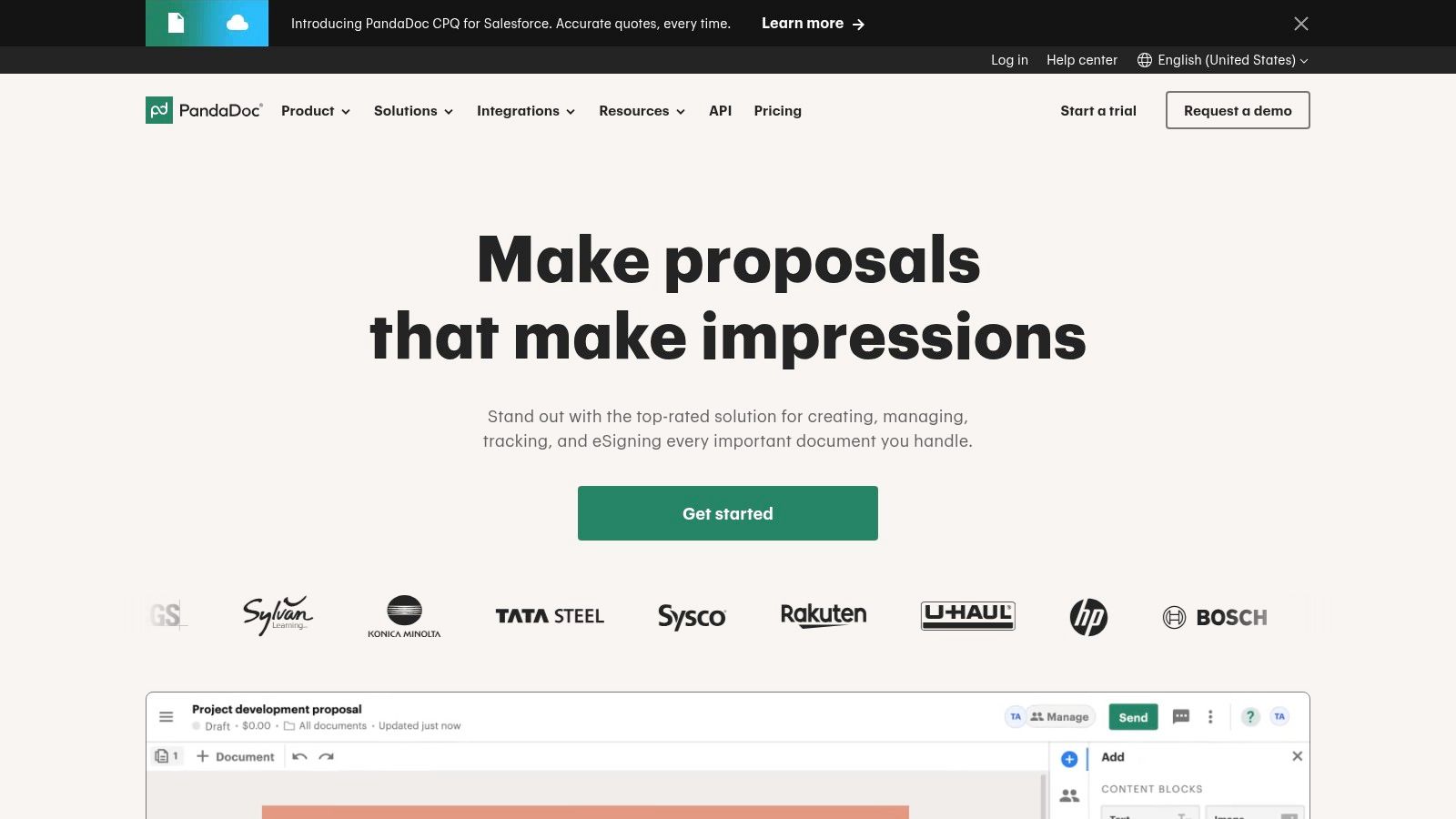
The platform’s strength lies in its interactive elements. Agencies can leverage the content library to store pre-approved case studies, team bios, and service descriptions, ensuring brand consistency and accelerating assembly. Its interactive pricing tables are a standout feature, allowing clients to select optional services and see totals update in real-time, which can significantly shorten an agency's negotiation cycle.
Key Features & Considerations for Agencies
- Best For: Agencies needing an integrated solution for creating proposals, managing contracts, and collecting signatures and payments in one place.
- Unique Selling Point: Unlimited e-signatures are included across all paid plans, a significant value proposition for agencies compared to competitors who often charge per user or per signature.
- Pros: Fast to deploy and easy to use; robust template and content library features; strong security and compliance posture (SOC 2 Type II, GDPR, HIPAA available).
- Cons: Some advanced features like CPQ (Configure, Price, Quote) and identity verification are gated behind higher-tier plans or require paid add-ons.
Link: PandaDoc
3. Proposify: Best for Agency Sales Team Collaboration & CRM Integration
Proposify is a powerful proposal software built specifically with sales teams and agencies in mind. It excels at creating a structured, collaborative environment where teams can design, send, and track high-impact proposals with robust oversight. Its strength lies in features like role-based permissions, approval workflows, and deep integrations with CRMs like Salesforce and HubSpot, making it an ideal choice for agencies that need to maintain brand consistency and control across their sales process.
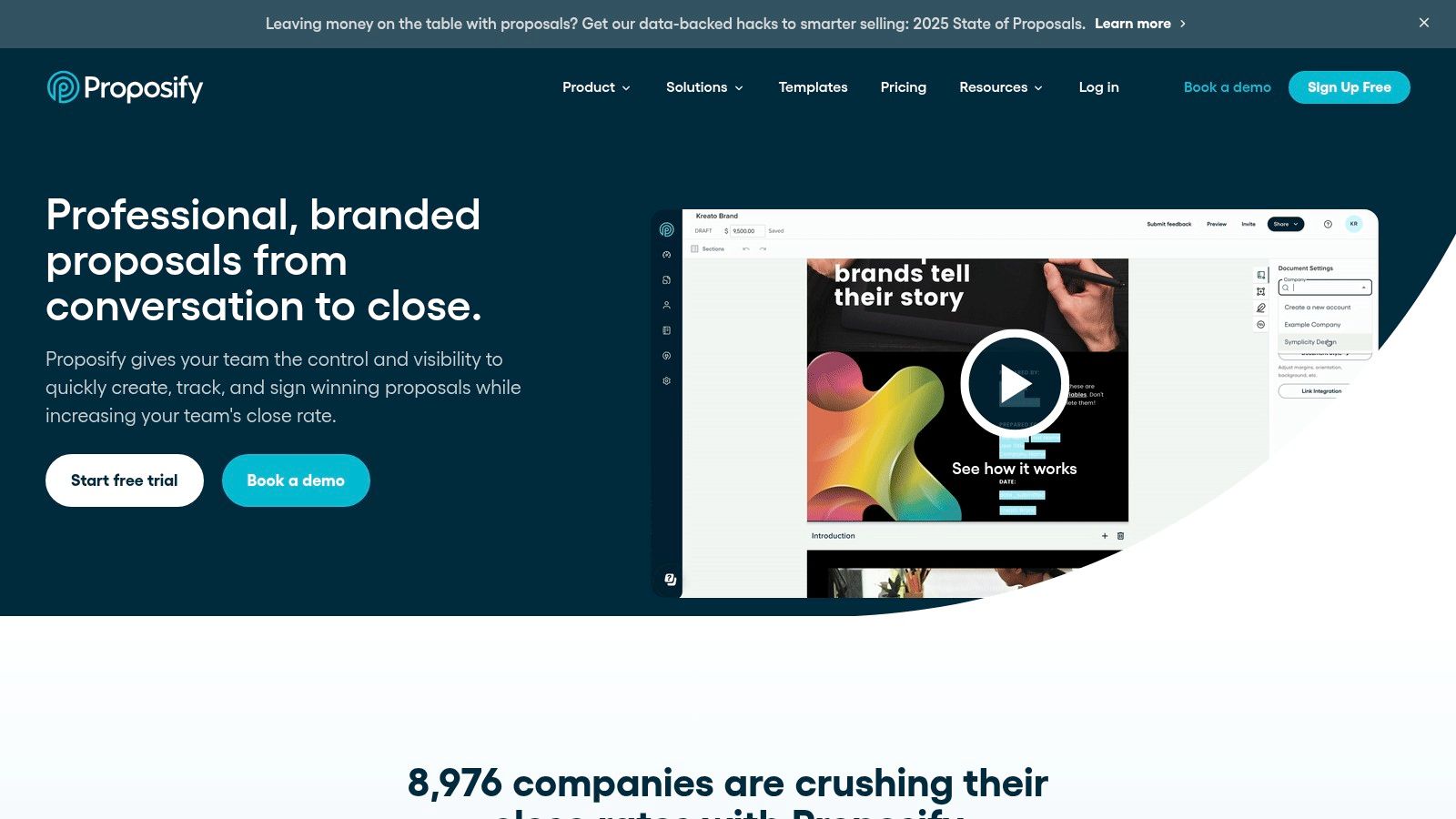
The platform streamlines proposal creation through a centralized content library, variables for personalization, and powerful templates. A key differentiator is its detailed analytics, which provide insights into how clients interact with proposals, including which sections they view and for how long. This data empowers agency account managers and sales reps to follow up with more targeted, effective communication, ultimately improving close rates for the agency.
Key Features & Considerations for Agencies
- Best For: Growing agencies and established sales teams that require strong CRM integration, approval workflows, and detailed engagement analytics.
- Unique Selling Point: The deep, native Salesforce integration available on the AppExchange allows sales teams to build, send, and track proposals without ever leaving their CRM.
- Pros: Straightforward and transparent pricing with a clear onboarding process; strong security posture with SOC 2 Type 2 compliance; excellent collaboration features for internal teams.
- Cons: Lower-tier plans have limitations on the number of active documents and collaborators, which may be restrictive for high-volume agencies.
Link: Proposify
4. Qwilr: Best for Visually-Driven, Interactive Web Proposals from Creative Agencies
Qwilr stands out by transforming traditional proposals into interactive, mobile-responsive web pages. It’s an exceptional choice for design-focused agencies and sales teams that want to deliver a polished, high-impact first impression. Instead of sending a static PDF, your agency can share a link to a beautiful, branded webpage, creating a more engaging and modern client experience that reflects the quality of your agency's work.
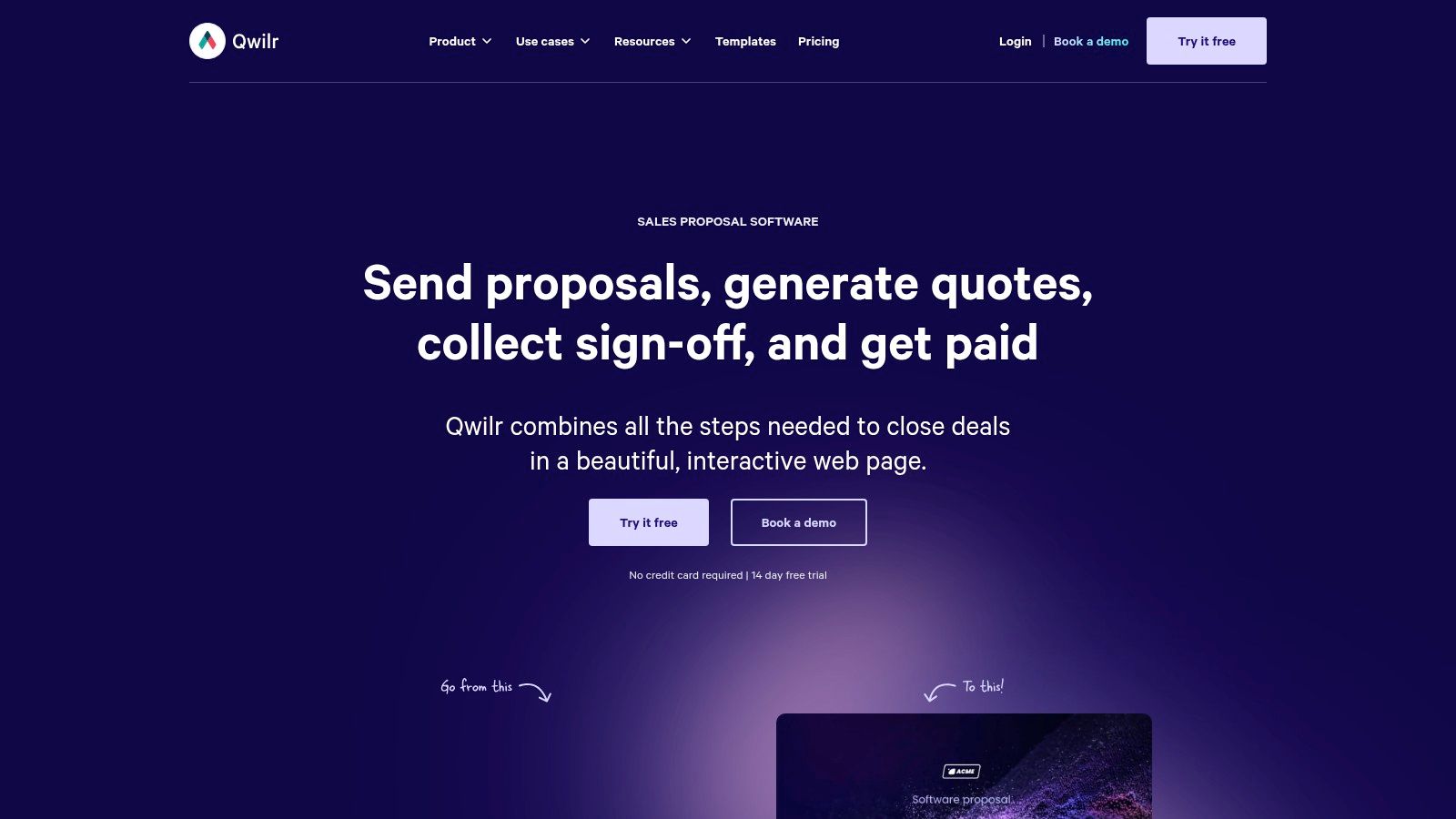
The platform's core strength is its powerful editor, which allows for embedding rich media like videos, interactive maps, and calendars directly into your proposal. Its deep integration with CRMs like HubSpot and Salesforce is a significant advantage, allowing agency teams to auto-populate proposals with client data, saving time and reducing errors. Qwilr's analytics provide insights into how clients interact with your proposal, showing which sections they view the most, which is invaluable for targeted follow-ups.
Key Features & Considerations for Agencies
- Best For: Creative, design, and tech agencies that prioritize a visually stunning and interactive proposal experience and rely heavily on CRM data.
- Unique Selling Point: The ability to create proposals as standalone, trackable webpages rather than documents, with robust analytics and custom domain options.
- Pros: Produces highly polished, on-brand proposals as shareable links; strong integration with HubSpot and Salesforce; powerful real-time analytics.
- Cons: The Enterprise tier has a 10-seat minimum, which may be a barrier for smaller agency teams; advanced features are gated behind higher-tier plans.
Link: Qwilr
5. Better Proposals: Best for Simple, Fast Proposals with Flexible Pricing for Small Agencies
Better Proposals is engineered for speed and simplicity, making it an excellent choice for freelancers, small agencies, and SMBs that prioritize creating visually appealing proposals without a complex setup. The platform focuses on a streamlined user experience, allowing users to go from a blank slate to a sent proposal in minutes. Its clear, tier-based allowances and pay-as-you-go options provide unmatched flexibility for agencies with fluctuating proposal needs.
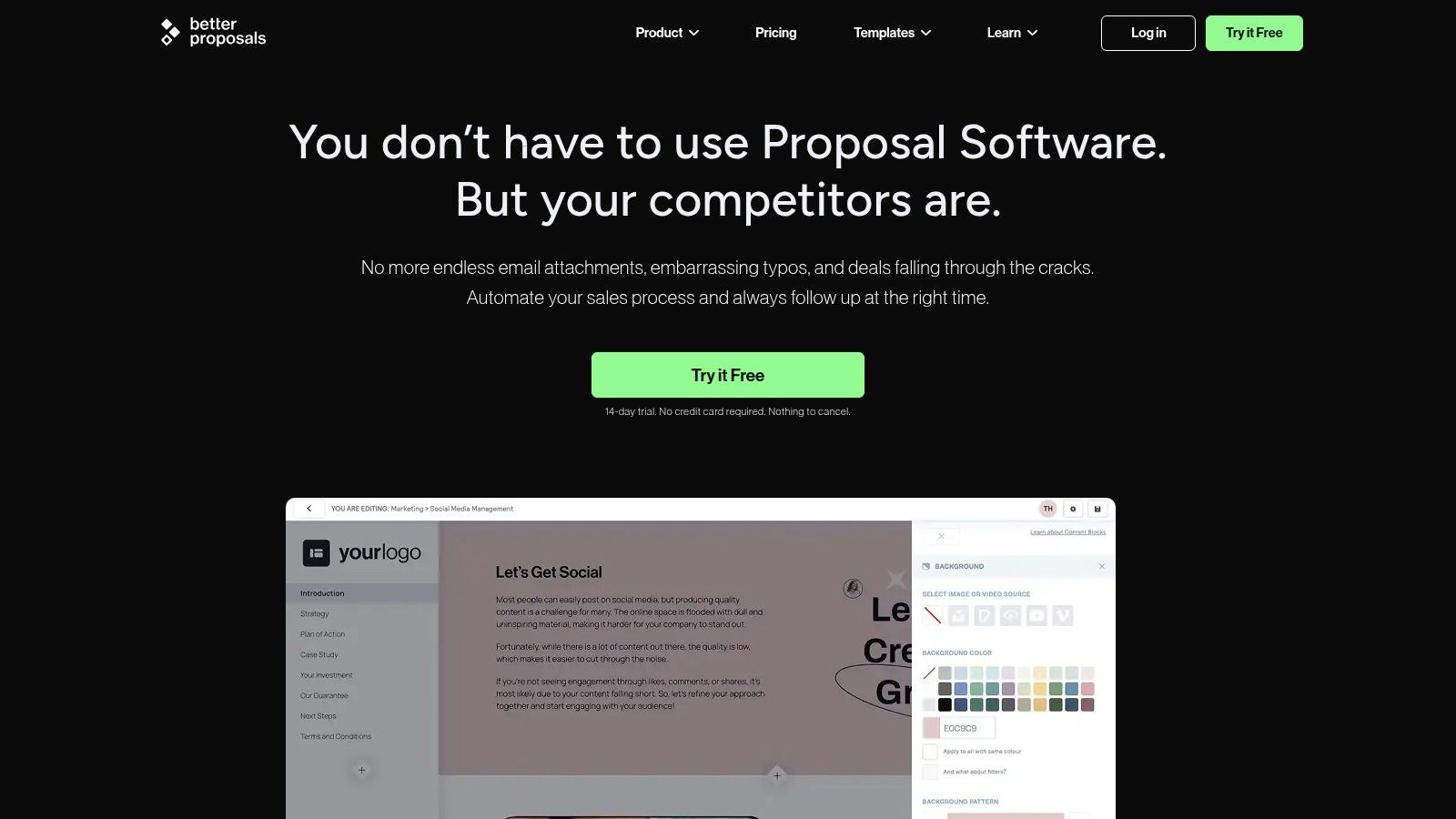
The platform shines with its intuitive editor and extensive template marketplace, which gives agencies a strong starting point for their documents. Features like a content library, digital signatures, and live chat support ensure a professional workflow. For agencies looking to master the art of proposals, learning more about how to create a proposal can complement the tool's capabilities. Better Proposals is a strong contender for teams that need a straightforward, effective proposal software solution that gets the job done quickly.
Key Features & Considerations for Agencies
- Best For: Freelancers and small-to-midsize agencies that require a fast, easy-to-use platform with flexible, transparent pricing.
- Unique Selling Point: A pay-as-you-go credit system for occasional senders, offering a cost-effective alternative to monthly subscriptions for agencies with low-volume proposal needs.
- Pros: Highly intuitive and easy to learn; flexible pay-as-you-go credits for light usage; clear allowances for proposal sends on tiered plans.
- Cons: Lower-tier plans have caps on the number of monthly proposal sends and included users, which may be limiting for growing agencies.
Link: Better Proposals
6. GetAccept: Best for Creating Interactive Digital Sales Rooms for Agency Clients
GetAccept positions itself as more than just proposal software; it’s a comprehensive digital sales room platform designed to manage the entire buyer journey. This makes it a strong contender for tech-savvy agencies that want to create a collaborative, trackable environment for their prospects. Instead of sending a static PDF, agencies can guide clients through an interactive space containing their proposal, videos, and live chat, fostering deeper engagement.
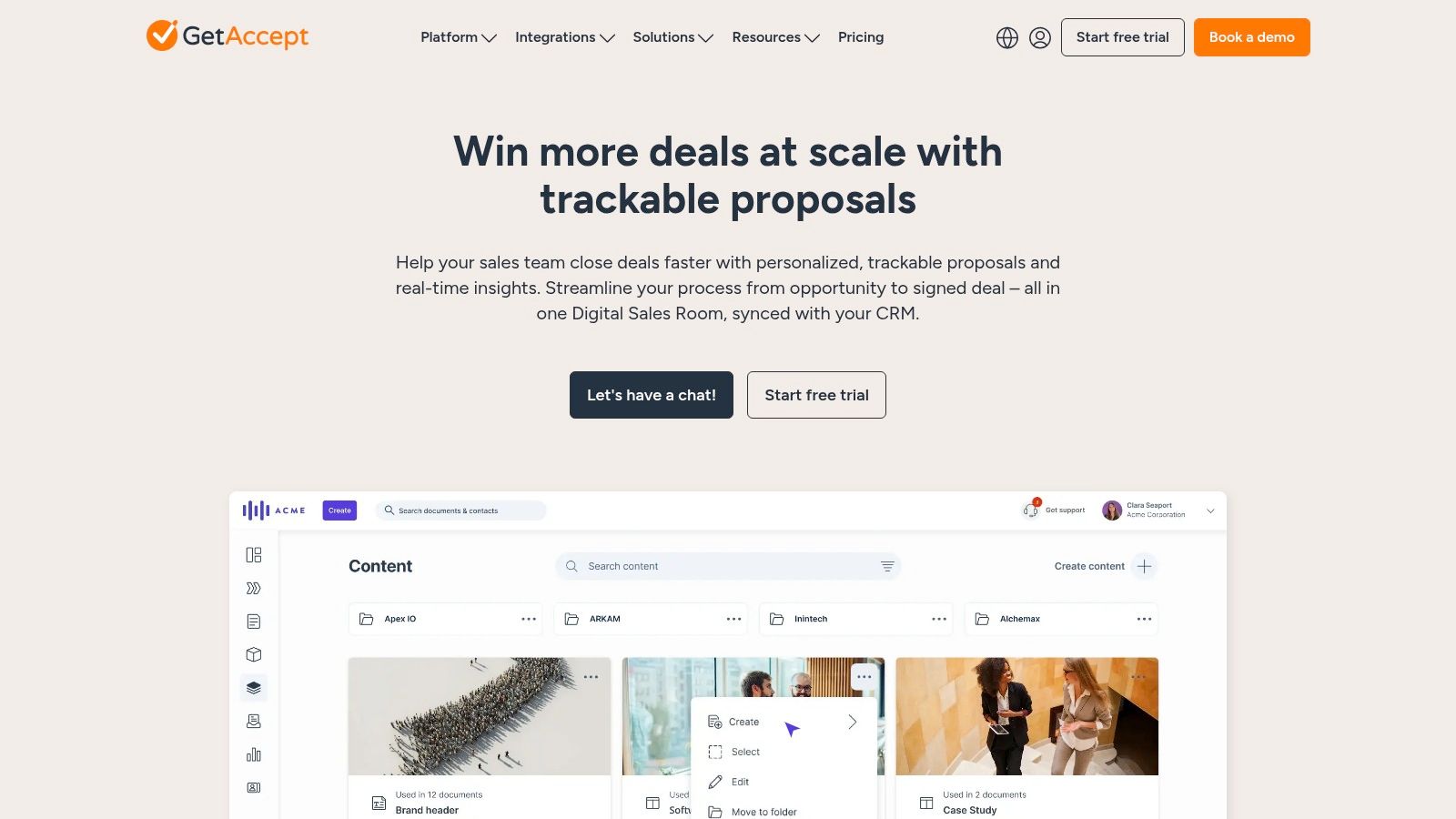
The platform’s core strength is its focus on engagement analytics. Agencies receive real-time notifications when a prospect opens, views, or comments on a proposal, allowing for perfectly timed follow-ups. With features that scale from simple e-signatures to full Contract Lifecycle Management (CLM) and CPQ functionality, it provides a clear growth path for agencies looking to formalize their sales operations and close bigger deals.
Key Features & Considerations for Agencies
- Best For: Agencies wanting to create a highly interactive and trackable sales experience that goes beyond a simple proposal document.
- Unique Selling Point: The "Digital Sales Room" concept, which centralizes all deal-related content (proposals, videos, chat) and stakeholder communication in one shared space for the client.
- Pros: Competitive entry-level pricing for core proposal and e-signature features; a clear upgrade path to advanced CLM and CPQ capabilities; strong engagement tracking tools.
- Cons: The Professional tier has a 5-user minimum, which may be a barrier for smaller agencies; advanced CRM integrations can increase the overall cost significantly.
Link: GetAccept
7. DealHub: Best for Complex, System-Driven Proposals for Tech or Service-Heavy Agencies
DealHub is a powerful CPQ-centric platform designed for agencies with complex pricing structures and approval hierarchies. It excels at generating system-driven quotes and proposals that are then presented in a collaborative, client-facing Digital DealRoom. This makes it an ideal proposal software solution for agencies that rely heavily on CRM data and have intricate pricing logic, such as those offering tiered software subscriptions or variable service packages.
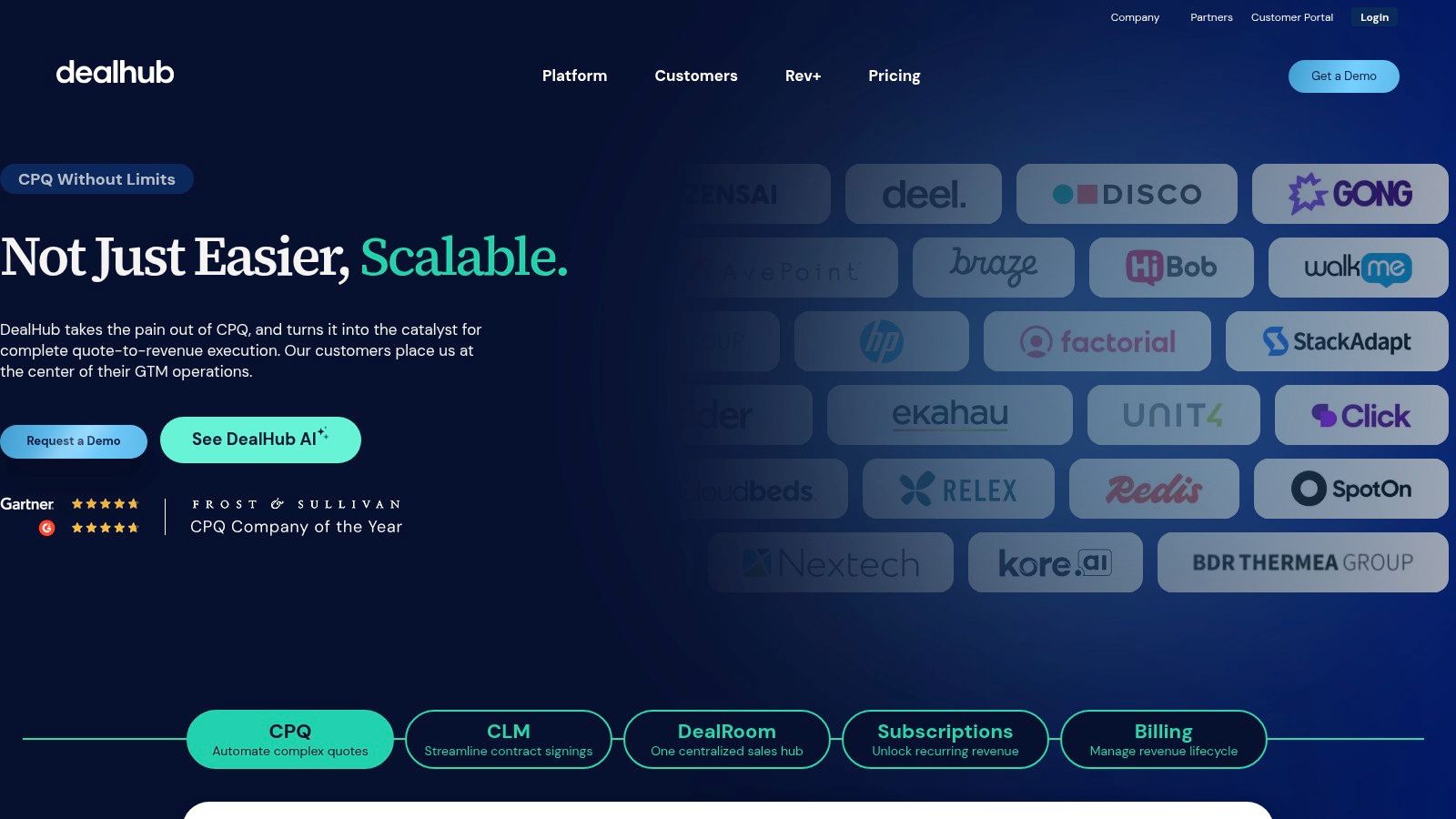
Its core strength is its guided selling and advanced approval workflows, which drastically reduce the risk of pricing errors and ensure that all agency proposals align with company policy before reaching a client. The platform's ability to integrate deeply with major CRMs like Salesforce and HubSpot, along with ERPs, means proposals are built on a solid foundation of accurate customer data, creating a seamless quote-to-revenue process.
Key Features & Considerations for Agencies
- Best For: Agencies with complex, multi-layered pricing models that require strict approval workflows and deep CRM integration.
- Unique Selling Point: The all-in-one Digital DealRoom, which consolidates the proposal, stakeholder collaboration, and e-signatures (DealSign) into a single, interactive web page for the client.
- Pros: Deep CPQ capabilities and robust approval workflows minimize pricing errors; strong, native integrations with major CRM and ERP systems; a unified environment for the entire deal lifecycle.
- Cons: Pricing is not publicly available and typically requires a sales-led demo and implementation process, making it less suitable for agencies needing an immediate, self-serve solution.
Link: DealHub
8. Responsive (formerly RFPIO): Best for Enterprise-Grade RFP Response for Large Agencies
Responsive, formerly known as RFPIO, is a heavyweight in the proposal software space, designed specifically for large organizations and enterprise agencies that regularly tackle complex RFPs, RFIs, and security questionnaires. It moves beyond standard proposal creation to offer a full-scale, AI-driven response management platform. Its core strength is its ability to centralize and automate the high-volume, collaborative effort required to win large-scale agency contracts.
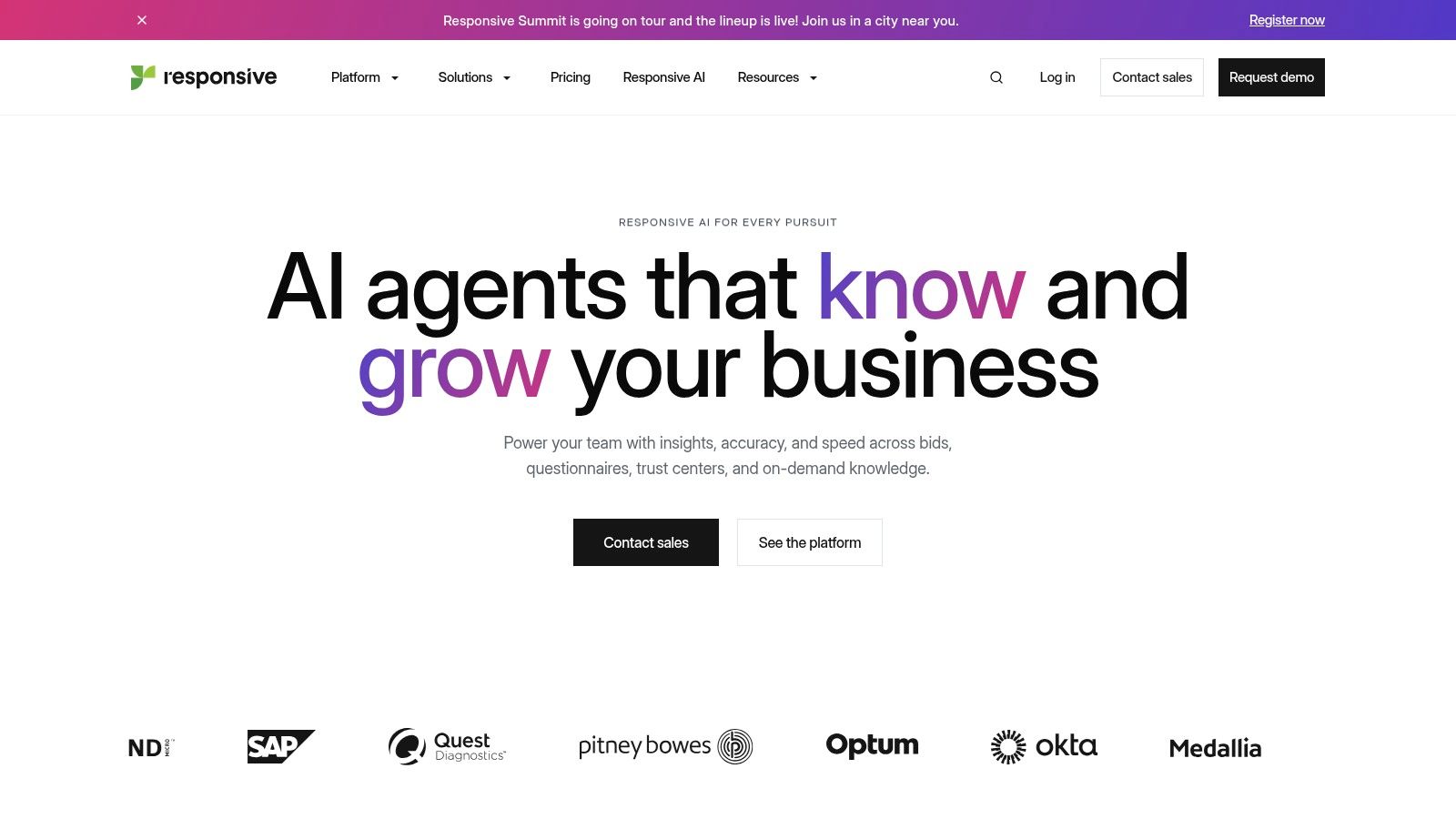
The platform’s AI-powered Content Library is its standout feature. It acts as a single source of truth, allowing agencies to store, manage, and instantly find pre-approved answers to common questions. The AI suggests relevant content, drastically reducing the time spent hunting for information and ensuring responses are consistent and accurate. This is invaluable for global agencies or those with siloed subject matter experts.
Key Features & Considerations for Agencies
- Best For: Large enterprise agencies or those with dedicated bid and proposal teams that need to manage complex, multi-stakeholder RFP responses.
- Unique Selling Point: The AI-assisted "Answer Library" and recommendation engine, which automates up to 80% of the question-answering process for mature RFP environments.
- Pros: Unmatched for managing complex RFPs; powerful collaboration and project management tools; strong security, compliance, and integration capabilities proven at the enterprise level.
- Cons: Pricing is not public and is geared toward enterprise budgets, often requiring annual contracts and a formal onboarding process, making it less accessible for smaller agencies.
Link: Responsive
9. Loopio: Best for Centralizing RFP & Security Questionnaire Responses at Scale
Loopio is less a traditional proposal creator and more a strategic response management platform. It's built for agencies that handle a high volume of complex RFPs, RFIs, and security questionnaires where accuracy and consistency are paramount. Rather than focusing on design, Loopio excels at automating the content-gathering process, making it ideal for larger agencies where sales, solutions architects, and legal teams must collaborate on responses.

The platform’s core is its intelligent central answer library, which uses automation to find and suggest the best pre-approved answers for new proposals. This drastically cuts down the time agency teams spend hunting for information and ensures every response reflects the most up-to-date company messaging and technical details. This sophisticated approach to content management makes Loopio a powerful piece of proposal software for scaling agency operations. For teams interested in how this integrates with broader workflows, these agency project management tools can offer complementary solutions.
Key Features & Considerations for Agencies
- Best For: Medium to large agencies or enterprise teams that need to standardize and automate responses to formal RFPs and security questionnaires.
- Unique Selling Point: Its "Magic" feature uses intelligent automation to auto-fill answers in a project, often completing a significant portion of a response instantly.
- Pros: Powerful content library with robust governance and review cycles; strong integrations with key CRM and sales enablement platforms; excellent customer support and onboarding services.
- Cons: No public pricing is available, requiring a sales consultation for a quote; can be overkill for agencies focused on simpler, design-heavy creative proposals.
Link: Loopio
10. QorusDocs: Best for Agencies Standardized on Microsoft 365
QorusDocs is a specialized proposal management suite designed for teams deeply embedded in the Microsoft 365 ecosystem. Instead of forcing users into a separate platform, it integrates directly into Word, PowerPoint, and Outlook, allowing agencies to build complex proposals, RFPs, and SOWs within a familiar environment. This makes it an excellent choice for larger or enterprise-level agencies where Microsoft Office is the non-negotiable standard for document creation.
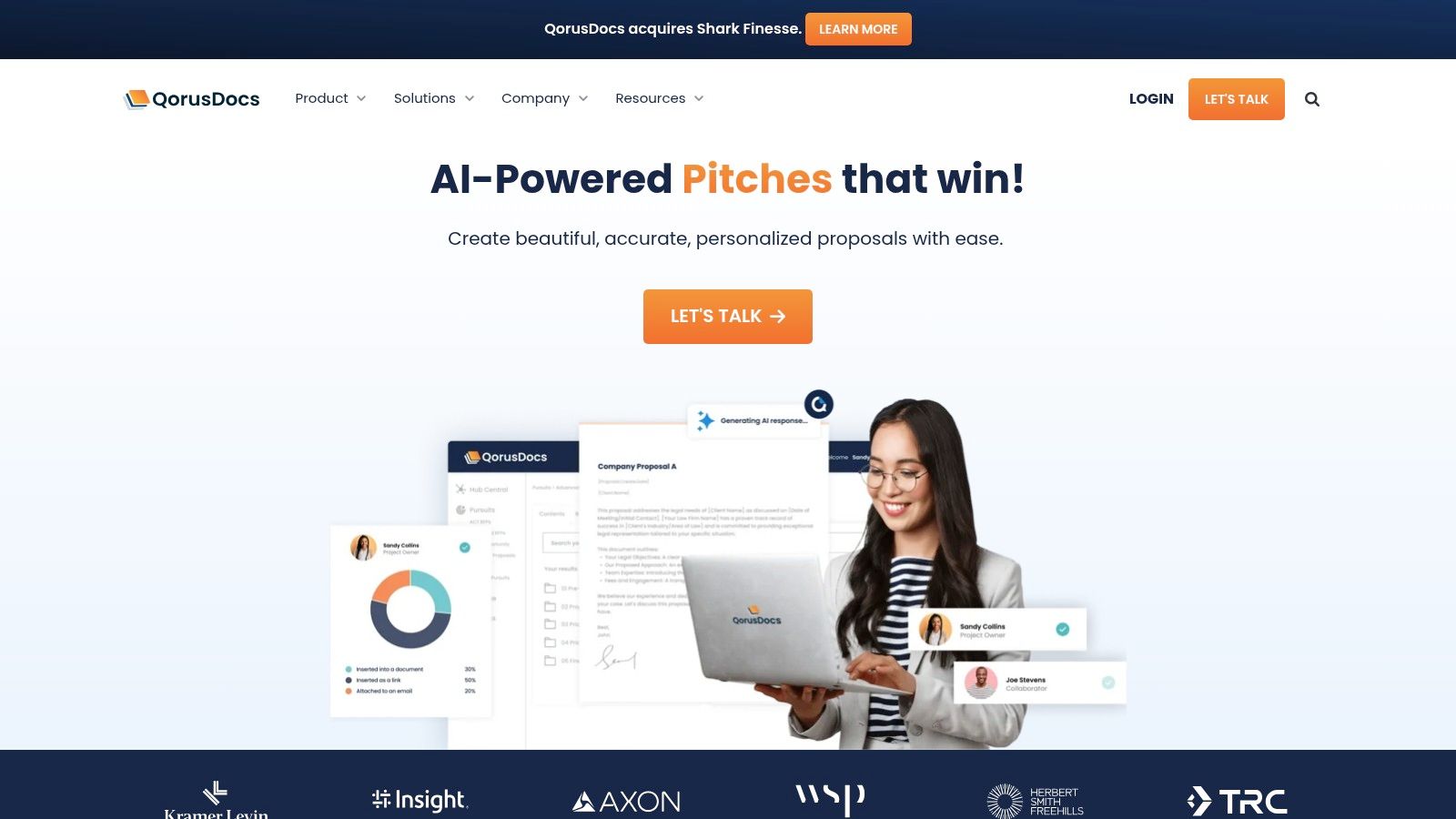
The platform’s power comes from its AI-driven content discovery engine, QPilot. It helps proposal managers quickly find and reuse pre-approved content like case studies, team bios, and technical specifications directly within their documents. This significantly reduces manual search time and ensures brand and messaging consistency across all client-facing materials. For agencies that handle a high volume of complex RFPs, this level of automation is a critical advantage.
Key Features & Considerations for Agencies
- Best For: Enterprise agencies or teams that live in Microsoft Office and need powerful, AI-assisted automation for complex proposals and RFPs.
- Unique Selling Point: Its deep, native integration with Microsoft 365, allowing users to leverage powerful proposal software features without leaving Word or PowerPoint.
- Pros: Dramatically speeds up content discovery and document assembly with AI; integrates seamlessly with the full Microsoft 365 suite; reduces user friction by leveraging a familiar interface.
- Cons: Pricing is not publicly available and requires engaging with their sales team; less suited for agencies looking for a lightweight, all-in-one web-based solution.
Link: QorusDocs
11. G2 – Proposal Software Category: Best for Unbiased Comparative Research for Agencies
While not proposal software itself, G2’s dedicated proposal software category is an indispensable research tool for agencies performing due diligence. It functions as a meta-resource, aggregating hundreds of verified user reviews, feature comparisons, and satisfaction ratings across dozens of vendors. This makes it the ideal starting point for agencies wanting to create a shortlist of potential platforms based on real-world feedback from peers in similar industries and company sizes.
G2 excels at providing a bird's-eye view of the market landscape. Agencies can quickly filter solutions by company segment (small business, mid-market), pricing models, and specific features, allowing for direct, side-by-side comparisons. The platform’s proprietary Grid reports visually map out market leaders versus high performers, helping decision-makers quickly identify established players and rising stars in the proposal software space.
Key Features & Considerations for Agencies
- Best For: Agencies in the initial research phase looking to compare a wide range of proposal software solutions using verified user reviews and data-driven rankings.
- Unique Selling Point: The sheer volume of recent, verified user reviews provides an unparalleled level of social proof and insight into user satisfaction that is difficult to find elsewhere.
- Pros: Extensive vendor coverage; powerful filtering options to narrow choices by budget and essential features; easy to sort by user satisfaction or market presence.
- Cons: Sponsored listings can influence vendor visibility, so it's important for agencies to look beyond top-of-page results; always verify features and pricing on the vendor’s own site.
Link: G2 – Proposal Software Category
12. Capterra – Proposal Management Software Directory: Best for Initial Vendor Discovery
While not a proposal software itself, Capterra’s Proposal Management Software Directory is an indispensable resource for agencies in the discovery phase. It provides a comprehensive, filterable database of over 200 proposal tools, allowing teams to compare options based on features, pricing models, deployment types, and real user reviews. This makes it an essential first stop for agencies aiming to create a shortlist of potential vendors before committing to demos.
For comprehensive research beyond our list, delving into resources like the Capterra Proposal Management Software Directory is crucial. You can also explore a comprehensive Capterra guide to boost SaaS growth, providing further insights into leveraging such platforms for lead generation and business expansion. The platform’s strength is its structured data, which helps agencies quickly identify tools that fit specific needs, such as integration with their existing CRM or specific compliance requirements.
Key Features & Considerations for Agencies
- Best For: Agencies at the very beginning of their research process who need to understand the market landscape and build a vendor shortlist.
- Unique Selling Point: Its detailed buyer’s guide and transparent ranking methodology provide valuable context, helping agencies make more informed decisions beyond just feature lists.
- Pros: Free to use with extremely detailed filtering; provides aggregated user review data and clear cost definitions; excellent for initial market research and vendor comparison.
- Cons: Listings can be sponsored, potentially influencing placement; users must always visit the vendor’s site to verify final pricing and feature limits.
Link: Capterra Proposal Management Software
Agency Proposal Software: Feature & Pricing Comparison
How to Choose the Right Proposal Tool to Win More Agency Clients
Navigating the landscape of proposal software can feel overwhelming, but making an informed choice is a strategic investment in your agency's future. As we've explored, the "best" platform is not a one-size-fits-all solution; it’s the one that aligns precisely with your specific operational bottlenecks, client expectations, and growth ambitions. The journey from initial client contact to a signed contract is complex, and the right tool acts as your agency's digital handshake, guide, and closing argument all in one.
This comprehensive review has showcased a wide spectrum of tools, from all-in-one powerhouses like PandaDoc and Proposify to design-centric platforms like Qwilr. We've seen how specialized systems like Responsive and Loopio are indispensable for agencies that live and breathe RFPs. Each tool offers a unique value proposition, emphasizing different aspects of the proposal lifecycle, whether it's speed, aesthetic appeal, analytics, or complex approval workflows.
How to Select the Right Proposal Software for Your Agency
Making the right decision requires a clear-eyed assessment of your agency's current processes. Don't get distracted by a long list of features you'll never use. Instead, focus on solving your most significant pain points.
- For Speed and Volume: If your agency's primary goal is to send a high volume of professional, templated proposals quickly, platforms like Better Proposals or GetAccept excel. They streamline the creation process, allowing your sales team to focus on selling, not document formatting.
- For Design and Brand Impact: Creative and digital agencies needing to make a strong visual impression should seriously consider Qwilr. Its web-based, interactive proposals can elevate your brand and create a more engaging client experience that static PDFs simply can't match.
- For Accuracy and Pre-Proposal Efficiency: A significant source of proposal error and delay happens before you even open a template. If your agency team struggles with inconsistent client discovery, inaccurate scope, or time-consuming manual drafting, a tool like Scribbl is essential. It automates the foundational work of gathering requirements and generating an initial draft, ensuring accuracy from the very start.
- For Complex Sales and RFP Management: For agencies responding to detailed RFIs and RFPs, the robust content libraries and collaboration features of Responsive, Loopio, or QorusDocs are non-negotiable. They transform a chaotic process into a manageable, data-driven workflow.
Beyond the Software: Agency Implementation and Integration
Remember, implementing new proposal software is more than just a subscription. It’s a change management process for your agency. Plan for team training, template creation, and integrating the tool into your existing CRM and project management systems. A smooth rollout is critical to achieving a positive ROI.
Furthermore, think about the entire client journey. Modernizing your proposal process is a huge step, but don't stop there. Consider how other modern tools, such as the digital business card, can further enhance your agency’s networking and client engagement, contributing to stronger partnerships. Every touchpoint is an opportunity to reinforce your agency's professionalism and forward-thinking approach.
Ultimately, the goal is to choose a platform that empowers your team to stop wrestling with documents and start building relationships. The right proposal software will not only save you countless hours but will also professionalize your agency's brand, provide critical insights into your sales pipeline, and help you turn more compelling proposals into profitable, long-term partnerships.
Ready to fix the most broken part of your agency's proposal process? While the tools above help you design and send proposals, Scribbl automates the painstaking work that comes before. Stop wasting hours on manual note-taking and scope drafting, and start generating accurate, client-approved project outlines in minutes with Scribbl.

